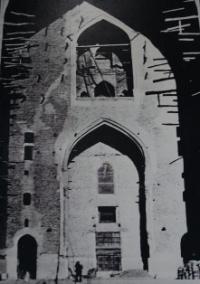You are here
History of Turkestan in manuscripts.

History of Turkestan.
“I've known rivers:
I've known rivers ancient as the world and older than the flow of human blood in human veins. My soul has grown deep like the rivers”
Langston Hughes.
Mausoleums in Turkestan.
Turkestan appears in Arab-Persian sources in the IXth - Xth centuries. In these sources Turkestan is named as Shavgar. The Arab traveler al-Istarhi writes "from Keder to Shavgar one day's journey, from Shavgar to Savran one day's journey."
Al-Istarhi also reports that the people of Shavgar were converted to Islam by the Samanid ruler Ahmed ibn Asad in 245 - 859, while several thousand people from the city's residents were beaten. At-Tabari in his "History" writes that the people of Shavgar already in 135 - 755 AD.
Were Muslims, and sided with the Alids against the Bukhara ruler Zinad ibn Salih and the Khorasan ruler Abu Muslim. Abu Muslim sent an army against Shavgar led by ibn al-Nadim. According to al-Maqdisi, "Shavgar is a large city surrounded by a mound, a mosque on the edge of the bazaar."
Ibn Yakut writes that "Shavgar is the city of the Turks". According to "Nasab-name" information, Khoja Ahmed Yassavi from Sairam arrives in the country of Yassy. At the beginning of the XIII century. in Yassy Khorezmshah Muhammad ibn Tekesh minted silver coins in his own name.
The name Shavgar after the X century is not found in the sources. And the name Karachuk Asan is found for the last time in the diary of the Armenian king Getum, who was heading to the headquarters of the Mongol khan in Karakorum.
At the end of the XIV century, in the "Zafar-name" of Sharaf ad-Din Yezdi, the name of Yassy is mentioned, and it is noted that "Yassy is a small village, there is a tomb of Sheikh Khoja Ahmed Yassavi". Since that time, Turkestan appears in medieval sources as Yassy.
Molla Shadi in the poem "Fath-name", dedicated to the Shaybanid khan Muhammad Shaybani, writes about the capture of Yassa and Otrar by Muhammad Shaybani khan and about the khakim of the city of Muhammad Marid Gurkhan.
Information about Turkestan is found in the works of Kamal ad-Din Ali Binai "Shaibani-name", Muhammad Haydar Dulati "Tarikh-i Rashidi", Mahmud ibn Wali "Bahr al-Asrar, Mas'ud Kuhistani" Tarikh-i Abul-Khair-khani ", Fazlallah ibn Ruzbihan Isfahani" Mikhman-name-yi Bukhara "and other sources.
These sources describe the events that took place in the XIV-XVII centuries in Desht-i Kipchak, Mogolistan. And they mention a lot about the city and district of Turkestan. Turkestan was, judging by the data of written sources, the hereditary inheritance of the ancestors of the first Kazakh rulers.
Even before Abulkhair came to power in Desht-i Kypchak, Janibek's father Barak owned Sygnak and other towns near Syrdarya. We know his message to Ulugbek demanding the return of a number of Turkestan cities that Timur had seized from the Jochids in due time.
This demand was substantiated by reference to the activities of their ancestors for the improvement of these cities, including the work of Urus Khan, who restored Sygnak. Utemish-khadzhi in "Chingiz-name" reports that Urus-khan was a great sovereign and "ruled the vilayets of all Turkestan."
As reported in written sources in the XIV - XV centuries. In Turkestan lived Kypchaks, Kangly, Argyns, Dulats, Jalair, as well as other representatives of the Turkic tribes who participated in the ethnogenesis of Kazakhs and Uzbeks.
In the sources of this period, its boundaries are quite clearly defined. In particular, Ruzbekhan Isfahani notes that the beginning of Turkestan is the Arkuk fortress, it is located one farsh from the Syr Darya. The road to the eastern fortresses of Turkestan passes through it.
The city of Sygnak was the border point of Turkestan. Here Turkestan ends behind Sygnak. Being close to Muhammad Sheibani, Ruzbekhan participated in his campaign in 1509. He describes Turkestan in this way "The country of Turkestan is one of the well-known inhabited territories and areas.
In its advantages and features, it really is a rarity on earth. Wise and learned people of all climates of the world liken the country of Turkestan to the head, because that the image of the improvement of the earth in the form of a person and the establishment of the characteristics of each part of the earth in accordance with the human body requires that this blessed land, among other lands, which [are attributed to] the qualities of other members of the human body, would be his head. along the bank of the Seikhun river".
Kamal ad-Din Ali Binai in "Shaibani-name" notes that "they (Sheibani and his companions) went to the" Vilayat Turkestan ", which included such famous cities as Sygnak, Sauran, Otrar, Yassy, Sairam, Arkuk, Uzgend, Ak-kurgan, Suzak and other cities of the Syr Darya basin.
In the XVth - XVIth centuries Turkestan lands were the arena of a fierce struggle between Sheibanids and Kazakh khans for power over nomadic tribes. It was this region that played an important role in the formation of Kazakh statehood."


Authority:
http://old.unesco.kz







